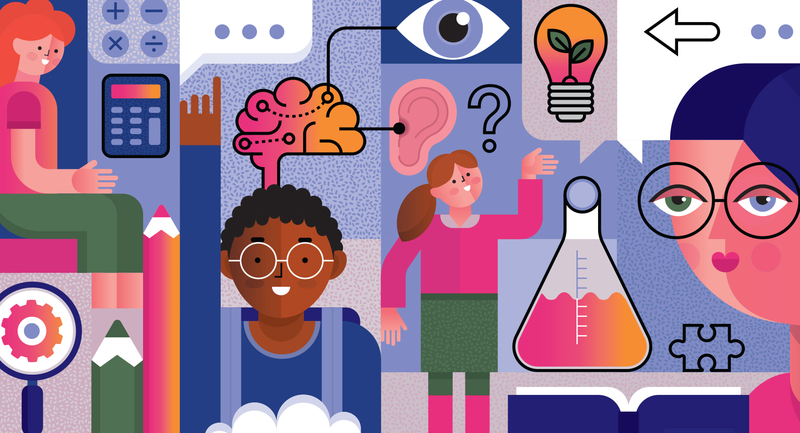Ohm's law, Boyle's law, and Newton's laws. Pascal's law and Pascal's triangle. Momentum and monarchies. Iambic pentameter and the area of a pentagon. Metaphors are not similes. Past participles, particles, and the future is perfect. Homer … but not that Homer. Ovid and osmosis. And someone killed a mockingbird. And, speaking of birds, why exactly was that caged bird singing?
How do students possibly keep up with it all? Many don't.
And while their brains desperately search for dim recollections of formulas, figurative language, or which axis is y, more information is incoming—information they must sort, organize, and put somewhere. Gaps in basic skills and in important background information that just didn't stick in long-term memory can make learning new concepts seem impossible.
Scaffolding can help students be more successful—and we don't need to wait until students falter midway through a lesson. Instead, teachers can plan in advance to provide the support students may need to fill in the gaps.
Why Plan for Scaffolding?
Scaffolding is a process of providing assistance to students so that they can perform a task today that would otherwise be out of reach. Like a physical scaffold that's built on a construction site to enable workers to reach high places they could not normally reach, instructional scaffolding is meant to lift students to a higher level of performance.
Consider two students in the same classroom with the same lesson introducing a new concept, probability. Both students are highly engaged in flipping coins. Class is off to a great start! Now the teacher says, "We're going to be using fractions today."
Student A is undaunted. But Student B freezes. His thoughts go immediately to his many unsuccessful experiences with fractions. "I'm terrible at fractions; don't they know that by now? Some number gets flipped—I remember that much. But is that with multiplication or division? Wait—something about common denominators. I hate fractions! I wonder if I can get a pass to the nurse …."
But suppose the teacher inserts scaffolding into this scenario: "Because we're working with fractions today, I've put a little bookmark on your desks with reminders about fractions, including examples that are correctly worked. It's been a while since you've used fractions, so tape one of these in your notebook for easy access. Look at it and take a moment to highlight things that are important to you."
Student B: "Whew! Some other kids don't remember all of this either."
The teacher has not given up on students who haven't mastered fractions yet. She has inserted a scaffolding device so that these students have a place to go for help. Instead of desperately searching their memories for information they missed before, they can now focus on the new concept, probability. Some students won't need the scaffolding; others will rely on it heavily; and some may use it for a while and then reference it less and less.
Scaffolding is a tactical instructional tool that helps students commit their mental resources to a new task. Why? Because with supports in place for gaps from the past, they sense that they have a better chance of success. Learning is risky business. Trying means going out on a limb and risking possible failure. Scaffolding can take some of the stress out of learning new concepts.
Looking Backward and Moving Forward
When gaps are present from past learning, we should try very hard not to add even more gaps. If Student B had been left to struggle through the lesson on probability without support, probability may have ended up as another concept the student hadn't mastered. And next year's teacher would have been faced with having to reteach both fractions and probability.
As a teacher, you can plan a great deal of scaffolding before the lesson begins by reflecting on what hurdles may exist for some students. During the planning process, first create a unit concept map and list the learning targets that students must reach to master the big goal. Next, step back and create a list of prerequisite skills required for student success.
It might be helpful to complete this sentence: My students could be successful on this upcoming unit if they only knew ___. For example, when planning a unit on writing, you may decide that students are more likely to master new learning targets if they understand the use of figurative language and know comma and capitalization rules. Now, reflect on the list. What supports can you put into place to reduce barriers to new learning for students who haven't mastered commas or capitalization? How could you help those for whom figurative language is a blur? Plan ways to provide such supports before the lesson even begins.
This doesn't mean that other needs for support won't develop. They will. But by anticipating some of our students' needs and creating bridges to new learning, we've proactively begun the work. Planning for scaffolding requires looking backward to recognize gaps from the past that could interfere with mastering the new learning target, and then looking forward to foresee hurdles in upcoming tasks.
For example, if students are going to do something new and more complex with calculators, you might provide a flow chart or list of steps. If they're going to read an especially dense passage of text, providing annotations of unfamiliar vocabulary will keep some students reading who might otherwise shut down. Marking certain paragraphs "important" or "skip this" can help students prioritize their efforts. In sum, we are providing supports for past gaps and heading off new ones.
And although scaffolding varies according to student and learning situation, experienced educators realize that there are patterns in gaps. There will always be students who battle with fractions, integer rules, or parts of speech. The expectation that every student will memorize multiplication tables or spelling rules at the same rate is unrealistic.
In sum, scaffolding preparation begins during the lesson planning process. The tweaking is done during class.
Examples of Scaffolding
There are as many examples of scaffolding as there are needs of students. Here are some staples to consider.
- Bookmarks are easy to create and use. They can be teacher- or student-made, and students can use them as a reference during class and then take them home for homework help. If the teacher makes the bookmark, it's important to give students time to examine it and perhaps highlight or underline items of particular importance for them. Grammar rules, verb conjugations, multiplication tables, perfect squares, integer rules, formulas, parts of speech, parts of a cell, types of government, food groups, vocabulary—bookmarks are perfect for memory-related items. Students can tuck them right into their books, minimizing any potential awkwardness an individual student might feel about having something different from his or her neighbor. Having said that, a case can be made for every student having one—just place them out on tables so that all students have access.
- Cheat sheets provided on a sticky note are perfect for small amounts of information requiring quick access, such as latitude and longitude, capitalization rules the class is using today, or the difference between area and perimeter. Teachers might anticipate the need for specific cheat sheets during planning, but this technique is typically implemented midlesson. Students should be encouraged to create their own cheat sheets.
- Chunking (breaking a concept down into steps) is a valuable scaffolding technique. In math, students who follow the steps exactly will land on the correct answer. Teachers might provide a flow chart or numbered list giving the steps for solving a math problem, writing an essay, completing a science lab, or creating a project. Breaking information into pieces can reduce cognitive load, make work more doable, and create a sense of accomplishment as the student reaches small goals.
- Graphic organizers can provide larger amounts of information that may not fit on a bookmark—for example, comparisons of mean, median, and mode; branches of government; or types of economies. Students may create graphic organizers for themselves, but teachers may also provide them or may partially create them and require students to fill in missing pieces.
- Mnemonic devices use novelty to help students remember surface-level information. Just about every math student has memorized "Please Excuse My Dear Aunt Sally" to remember the order of operations—parentheses, exponents, multiplication, division, addition, and subtraction. Teachers can create a sense of fun by teaching students mnemonic phrases for taxonomy order ("King Phillip Came Over From Great Spain"—kingdom, phylum, class, order, family, genus, species), the Great Lakes, the order of planets, colors in a rainbow, or trigonometry functions.
- Text marking allows teachers to annotate text for some students before the students read. For example, margin notes can provide definitions for important vocabulary words (if the word pervasive is used, the note might read "widespread"). In mathematics word problems, teachers can highlight, annotate, or underline key words. Stars can alert students to important sections or paragraphs. If students are reading a social studies chapter about four causes of the Great Depression, the teacher can insert numbers in the text where each cause is introduced. As learners get better at identifying text features and their purposes in reading, they will take these tasks more into their own hands.
Keeping Students in the Game
Life would be easier for students if they arrived in class every day with exactly what they needed to grasp the day's lesson. But in real life, students will always differ in background knowledge, basic skills, and the ability to memorize items at a prescribed time. Frustration looms as they get excited about a new math or physics concept but falter in doing the necessary calculations because they still haven't mastered multiplication or even subtraction. Discouragement weighs them down as they try to write about original ideas they want to share, but get bogged down on punctuation or the proper structure of a paragraph.
Scaffolding in context gives students an opportunity to stay in the game and experience success today. Although reteaching every concept missed along the way is impossible, scaffolding provides an opportunity to lift students up to the next level by providing what they need to move ahead right now. The good news is that teachers can often anticipate the instructional supports students will need and integrate these supports into the lesson—just in time for new learning.









